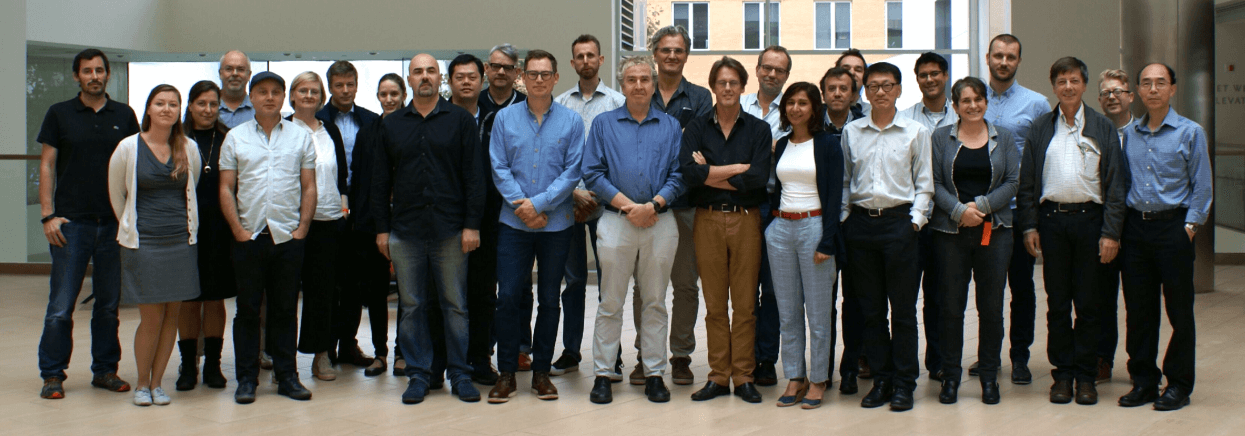SynGO is a public knowledgebase for synapse research providing:
- ontologies for the synapse. An ontology is a framework of definitions called ‘terms’ to describe gene/protein functions and locations and their relationships.
- synaptic genes/protein annotations and statements linking genes to specific terms. In the case of SynGO, annotations are based solely on published experimental evidence, curated by world-leading experts in synapse biology.
- online analysis and visualization tools to evaluate locations and functions of individual synaptic genes or to perform ‘enrichment’ studies.
Using the SynGO knowledgebase you can:
- search for synaptic proteins, find related proteins, evaluate the evidence for their synaptic localization and/or function and use links to other information on synaptic proteins/genes.
- analyze gene/protein sets from your -omics experiments and discover how your data is structured, which proteins are synaptic, where they localize in the synapse and what they may do. SynGO webtools help you to explore your data and visualize the analysis results.
- upload new annotations for synaptic genes/proteins using the annotation interface.
SynGO is a unique resource:
- SynGO is collectively supported by the international synapse research community.
- SynGO is the first all-inclusive ontology of the synapse. It represents all synaptic localizations and all aspects of synaptic function in a single ontology in an unbiased manner.
- SynGO is built exclusively on evidence from published experiments that can be evaluated by users.
- intuitive webtools provide advanced analysis and visualization opportunities.
A detailed description of SynGO was published in 2019; Koopmans et al., 2019, Neuron.
Why SynGO?
Synapses are fundamental information processing units of the brain and synaptic dysregulation is central to many brain disorders (‘synaptopathies’). However, systematic annotation of synaptic genes and ontology of synaptic processes are currently lacking. Synaptic transmission is orchestrated by a large collection of proteins on either side of the synapse, encoded by probably a few thousand genes. Decades of research have provided parts lists of the synapse and many hints on how these proteins work together to drive synapse functions. However, over-arching models to represent this large body of information has not been available. SynGO is established to alter this situation and fill this void.
There is a great need for structuring biological data in a computer searchable format. That is what SynGO allows you to do. SynGO opens the possibility to retrieve data on the evidence of being synaptic, data manually inspected by experts with literature references added. Also SynGO allows you to perform searches with larger sets of gene or protein data, to establish the synaptic signature of the content, to establish enrichment in certain terms and categories of the synapse. Entries can be gene or protein expression studies, genetic GWAS studies, etc.
SynGO allows you to explore synaptic data with the comfort of knowing that the underlying data has been carefully annotated by experts in the synapse community.
The SynGO consortium
SynGO was initiated in 2015 with a meeting of international experts on the synapse at the Stanley Center. This jamboree explored the possibilities of forming a consortium to generate a world-wide acceptable format for synapse ontology and annotation. CNCR (www.cncr.nl, depts. MCN & FGA, VU University Amsterdam), together with the Stanley Center, the Broad Institute (www.broadinstitute.org/stanley, Cambridge, MA, USA) pulled off this worldwide synaptic gene annotation effort. Guus Smit & Matthijs Verhage coordinate the project. SynGO builds on prior initiatives generated in European consortia on synapse research EU-Synapse, EuroSpin and SynSys. This was followed by the assembly of a 15 expert synapse groups that contributed to this process. The GO-consortium became our annotation partner. In 2016, the ontology structure was designed by achieving consensus on fine-graded functional and localization ontology terms. In 2017 and 2018 ~1300 papers were selected and read by experts to create ~3000 annotations (statements on protein location or function) for ~1100 unique proteins to SynGO.

In 2019 we published the SynGO effort. You can find a description of SynGO, an exploration of the synapse and various types of analyses in our paper: Koopmans et al., 2019, Neuron.
The Synapse Community
SynGO started with building consensus ontology, annotation and curation by key opinion leaders in the field. However, the current SynGO database relies on the active participation of the Synapse community, together forming the contributors to new entries. We have generated a transparent, open structure for synaptic annotation with minimal a priori decisions. Additions or change to the database can be made in this webtool. SynGO can only expand by the help of many. Click here to contribute.
